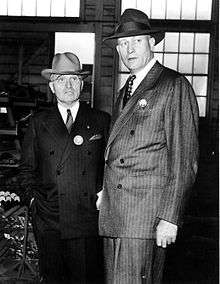Charles E. Moore
| Charles E. Moore | |
|---|---|
 Charles Moore (right) with US Senator Harry S. Truman at the Joshua Hendy Iron Works (1942) | |
| Born |
21 April 1894[1] San Bernardino, California United States |
| Died |
19 June 1953 (aged 59)[2] San Mateo, California |
| Nationality | American |
| Occupation | Industrialist |
| Known for | Manufacture of liberty ship engines during World War II |
Charles Edward Moore (21 April 1894–19 June 1953) was an American industrialist who is best known for his contribution to the maritime shipbuilding industry during World War II.
Early life and career
Charles E. Moore II was born in San Bernardino, California, to Charles Edward Moore, a Canadian immigrant, and E.A.M. Kinkaid.[1] His father established the jewelry firm of Moore & Lewis.
After completing the eighth grade, Moore entered the workforce, working as a machinist at the Santa Fe Railroad. At age 18, he became a “boomer”, the machinist’s name for a drifter. He traveled all over the U.S. and Mexico until the age of 21, at which time he set his sights on working at a certain machine tool company. As legend has it, Moore’s ambitions were thwarted by the owner who told him that he didn’t have the education to succeed.[3] “I was horribly insulted” he later said, “but then I calmed down and realized that he was right.” So he enrolled in high school as a 6-foot-6-inch, 285-lb freshman and finished four years' work in one.[4]
Moore entered the U.S. military (1917-1918), serving as a lieutenant in the Coastal Artillery.[5]
After leaving the military, Moore again applied to work at the machine tool company. He was hired and quickly moved into more responsible positions. In 1927 he bought the company, renaming it: “The Moore Machinery Company”.[6]
World War II
Moore ascribed to “a fundamental policy of never selling a machine that we wouldn’t take back if the customer didn’t like it”.[4] It was this policy that eventually led to Moore's purchase of the Joshua Hendy Iron Works in Sunnyvale, California. He visited the plant in response to a complaint from the owner. Seeing the plant's vast largely-untapped potential, he and his partners (The Six Companies) purchased Hendy for $500,000 in November 1940.[7] In seven years (1940 to 1947) through World War II, largely under Moore's leadership (Moore left the company in March 1946) Hendy grew from 60 employees to over 11,000. During the war, the Hendy work force, "The Iron Men and Women of Hendy", produced an astounding 754 Triple Expansion EC-2 Engines (used to power Liberty Ships) at the rate of one every 40.8 hours.[8] The engines weighed 137 tons (274,000 pounds) and were 24 feet (7.3 m) tall.[9] Moore became known as "America's No. 1 'Can Do' Man".[10]
In mid 1942, Moore and his partners also bought the Crocker-Wheeler Electrical Mfg. Co. in New Jersey, for $3,200,000.[11] After the war, Moore sold his interest in Hendy to his partners,[12] and spent much of his time traveling as a technical advisor on heavy machinery for the government. In 1941 he had traveled to The United Kingdom for the US office of Production Management, Harriman Commission, to advise tool manufacturing plants there.[3] Following the war he was an industry consultant in Greece for the State department. He went to Italy in 1947–49 as a Marshall Plan consultant.[13]
Boy Scouts of America
Moore became involved in the Boy Scouts of America (Santa Clara Council), as VP and chairman of the Boy Scout Memorial Foundation Board. In 1954 a building in Santa Clara was dedicated as "The Charles E. Moore Memorial Boy Scout Building" at the corner of Park & Newhall.[14]
Death
Moore died unexpectedly on 19 June 1953 of a massive heart attack while horseback riding in San Mateo. He is buried in San Jose's Oak Hill Memorial Cemetery.[15]
Footnotes
- 1 2 California Births & Christenings 1812-1988, Charles E. Moore
- ↑ California Death Index 1940-1997, Charles Edward Moore II
- 1 2 Wolf, Donald E., Big Dams and other dreams - The Six Companies Story (1996) University of Oklahoma Press, pp. 98-99. ISBN 0-8061-2853-4
- 1 2 "Archived copy". Archived from the original on 8 July 2011. Retrieved 2009-03-10. Gayer, George F., The Iron Men of Hendy (1985). p. 15
- ↑ United States World War I Draft Registration Cards 1917-18, Charles Edward Moore
- ↑ "Archived copy". Archived from the original on 8 July 2011. Retrieved 2009-03-10. Moore Machinery Co. History
- ↑ "Archived copy". Archived from the original on 8 July 2011. Retrieved 2009-03-10. Waldo, Jonathan, The Impossible Takes Longer, San Francisco Chronicle (10 May 1942)
- ↑ Engine #754 at Joshua Hendy Iron Works - Sunnyvale Public Library Digital Collection
- ↑ "Archived copy" (PDF). Archived from the original (PDF) on 18 March 2009. Retrieved 2009-03-21. Joshua Hendy Iron Works (brochure produced by ASME)
- ↑ "Archived copy". Archived from the original on 8 July 2011. Retrieved 2009-03-10. Letts, Robert Charlie Moore Called America's No. 1 'Can Do' Man, The San Francisco News
- ↑ "Perfect Hedge", Time Magazine (30 November 1942)
- ↑ "Machine Maker for the West", Time Magazine (25 March 1946)
- ↑ History of Santa Clara County Boy Scouts of America, ISBN 0-9628133-0-3, Biographies: p. 145
- ↑ "Archived copy". Archived from the original on 8 July 2011. Retrieved 2009-03-10. Sturrock, James P., Scouting in the Santa Clara Valley, the 70-year Adventure 1920-1990, ISBN 0-9628133-0-3. pp. 116-17
- ↑ Find A Grave, Charles Edward Moore II
References
- Wilson, Neil C. and Taylor, Frank J. (1957): The Earth Changers, Doubleday & Company, N.Y. Library of Congress Catalog Card # 57-7288
- Joshua Hendy Iron Works (Sunnyvale Public Library)
- Iron Man Museum (Sunnyvale, California)
- Charles E Moore Website
- Charles E Moore Video Re-enactment on YouTube